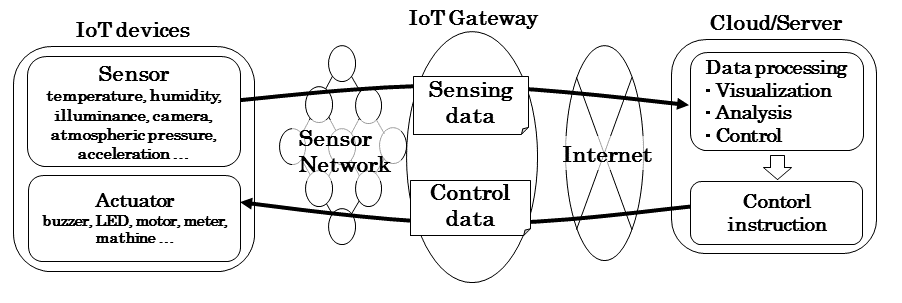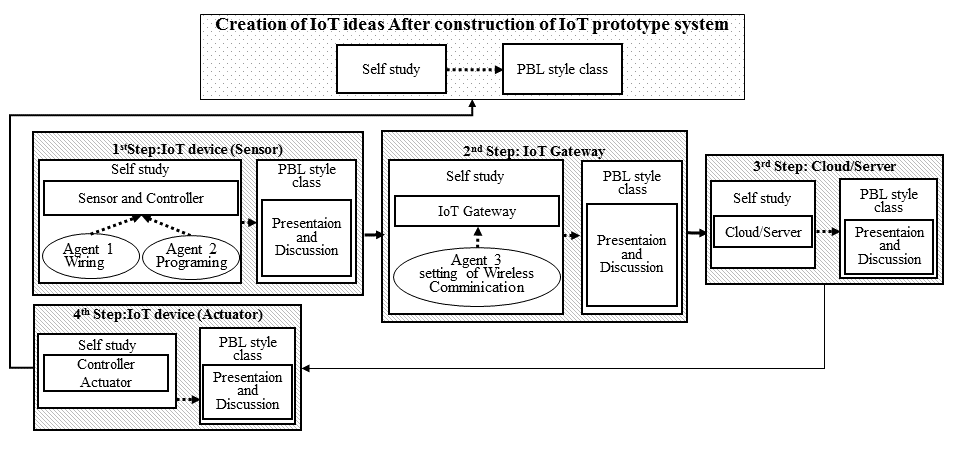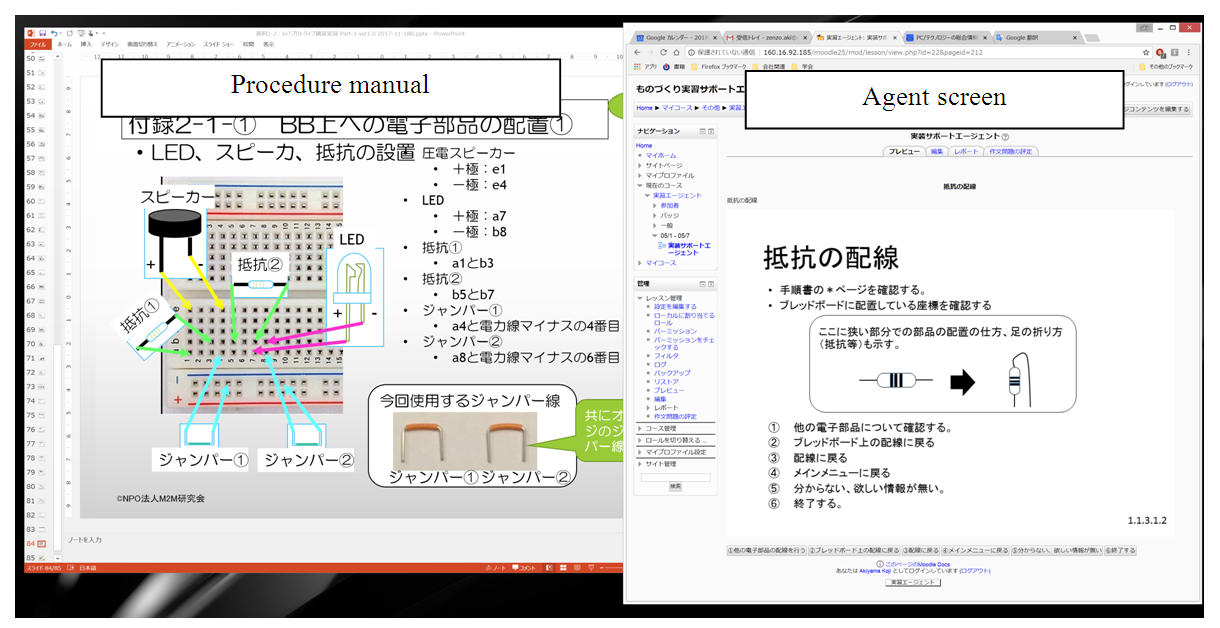-
Paper Information
- Paper Submission
-
Journal Information
- About This Journal
- Editorial Board
- Current Issue
- Archive
- Author Guidelines
- Contact Us
International Journal of Internet of Things
2018; 7(2): 30-36
doi:10.5923/j.ijit.20180702.02

Problem-based Learning Style IoT System Education Method by Student's Self-construction of Prototype System
Koji Akiyama
Itec Hankyu-Hanshin Co. Ltd., Tokyo, Japan
Correspondence to: Koji Akiyama, Itec Hankyu-Hanshin Co. Ltd., Tokyo, Japan.
| Email: |  |
Copyright © 2018 The Author(s). Published by Scientific & Academic Publishing.
This work is licensed under the Creative Commons Attribution International License (CC BY).
http://creativecommons.org/licenses/by/4.0/

Internet of Things (IoT) systems have been applied increasingly in many areas including industry, agriculture, traffic, welfare, and education. To expand the application field, it is important to create ideas that exploit the characteristics of each field. As described herein, we propose an educational method for students to implement IoT prototype system by self-construction, and to present and discuss ideas of IoT system service in PBL style classes. Teacher assistance is important for producing products such as the wiring of electronic parts in construction practice. Therefore, we prepared three agents to support practical training instead of a teacher. The IoT system education method consists of a stepwise system construction in four steps by self-study and PBL style class, and a final step during which ideas for services using IoT systems are created after practical learning. After applying the method to the study of students of a science and engineering university, conducted an evaluation.
Keywords: IoT prototype system, IoT service ideas, Education, PBL style class, Agent support functions
Cite this paper: Koji Akiyama, Problem-based Learning Style IoT System Education Method by Student's Self-construction of Prototype System, International Journal of Internet of Things, Vol. 7 No. 2, 2018, pp. 30-36. doi: 10.5923/j.ijit.20180702.02.
Article Outline
1. Introduction
- Internet of Things (IoT) systems incorporate devices that include sensors and facilitate their mutual communication. Typically in such systems, equipment and servers on the cloud are cross-connected via networks, with automatically accumulated data transmitted and received without human intervention to provide various services [1].In actuality, IoT systems have been applied to various applications including industry, traffic, facilities, industries, agriculture, distribution, medical care, welfare, and education. For the expansion of fields of application, it is important to create ideas associated with characteristic features of the respective fields. Furthermore, it is effective to construct prototype systems to elucidate IoT systems comprehensively. Students come to understand IoT system characteristics during construction work. They have the possibility of creating ideas of IoT services.Prototype construction includes steps of wiring sensors and actuators, creation of programs for acquiring and processing device input–output data, setting wireless communication between the device and the gateway, and setting a gateway function between the device and the cloud, along with cloud data processing. Among these steps, a teacher’s direct support is necessary for sensor and actuator connection and for controller programming because they entail many elements of manufacturing. Similarly, setting wireless communication requires direct teacher support because students must set many parameters in this step. If agents provide support to students instead of teachers, then self-study of constructing an IoT prototype system becomes possible. Additionally, one can provide students with Problem-Based Learning (PBL) style education by which students present results of self-study and ideas for IoT systems and then discuss them. This education allows students to think deeply about an IoT system, leading to more realistic ideas. This education also reduces teacher burdens in IoT prototype construction education.Conventional studies of IoT system construction have explored the IoT system architecture and technologies of its constituent elements, particularly the application of specific fields [2-6]. Nevertheless, almost no report describes a study of the IoT system construction method. Regarding the method, only in the software field is an efficient development method by the framework reported [7, 8].After proposing an educational method of IoT prototype system construction for students of the humanities course, we applied it for a class [9-11]. For prototype system construction, composition elements should be combined in a stepwise fashion while one gains information related to actual circumstances. However, the teacher burden was heavy because one teacher supported multiple students: almost all students waited for teacher support. As a result, the practice work progress did not proceed well. Moreover, students did not present or discuss their ideas because this class was not PBL type. Therefore, we were unable to lead them to a new awareness or brush up ideas realistically.Herein, we propose a PBL style IoT education method with student self-construction of a prototype with agent support functions. The main points are explained below.(1) We provide students with a learning system that has agents supporting the construction of an IoT prototype instead of a teacher. Thereby, students can construct prototype systems through self-study. We provide the following three important agents for IoT prototype construction: they are a "wiring support agent" that supports the wiring work of electronic parts, a "programming support agent" that supports creation of a program to acquire and transmit sensor data, and a "wireless setting support agent" that supports the wireless communication setting.(2) We provide students with procedure manuals and let them construct a prototype system through self-study. Furthermore, in the class, we provide students with PBL style education by which students present the results of self-study and ideas of the IoT system and discuss them. Moreover, we lead students to causes underlying stumbling points in their practices, fostering new awareness.(3) After students experience IoT system construction, we make students create ideas to apply IoT system which is a solution to familiar problems to students. In class, students present ideas and discuss them, thereby leading to new awareness and more realistic ideas.This education method was practiced at a science and engineering university. Then evaluation was conducted.
2. IoT Prototype System
- Figure 1 presents a typical basic configuration of an IoT system and data flow. The figure shows that the IoT device transmits sensing data acquired by sensors to the IoT gateway via the sensor network. The IoT gateway transmits the sensed data to the cloud via the internet. The sensing data are processed on the cloud with visualization and analysis, causing IoT device actuators to actuate via the IoT gateway. Consequently, with IoT systems, plural elements work together to establish an effective system.
 | Figure 1. Basic configuration IoT system |
3. Proposed PBL Style IoT System Education with Student Construction of a Prototype System
3.1. Composition of IoT Prototype System
- Figure 2 portrays the basic configuration of the IoT prototype. The figure shows that the IoT prototype system comprises an IoT device, a gateway, and a cloud/server. The IoT device includes sensors and actuators; open hardware Arduino [12] and Raspberry Pi [13] are used. Regarding actuators such as color LEDs, buzzers, and motors, their operations are confirmed easily. Sensors such as those for temperature, humidity, and atmospheric pressure are easily handled. ZigBee [14] supports the sensor network. As the IoT gateway, PC or Raspberry Pi can function as a gateway for IoT device side networks, with cloud network side gateways. M2X [15] is used as the cloud service.
 | Figure 2. Basic configuration and stepwise construction of IoT prototype system |
3.2. Stepwise Construction of IoT Prototype System
- (1) First stepThe first step covers sensors and actuators on the IoT device. Through this practical training, students produce a circuit on a substrate using electronic parts such as sensors, actuators, and jumper wires. This encourages students to experience manufacturing. When wiring work does not proceed well, students call the wiring support agent, use the information from the agent as a hint, and address the difficulty again. Furthermore, students create a program to obtain sensor values. If some point about this programming arises that they do not understand, then they call the programming support agent and tackle programming with information from the agent as a hint. Then they produce the IoT device by connecting the circuit and an Arduino. The program is run. Values acquired by sensors are checked. In the class, each student presents results of these tasks and discusses their contents. This education method allows the students to confirm the difficult or missing parts of the process. Finally, the student will notice a better way and have better understanding of the IoT system.(2) Second stepThe second step covers IoT devices, sensor networks, and IoT gateways. Students implement the IoT gateway on a Windows PC, run the program, and display the data as a graphical representation acquired by sensors and transmitted from the gateway. For mutual communication of the IoT device and gateway, wireless ZigBee is used. Students set up configuration of wireless ZigBee. When some point is unknown in setting, they inquire to the wireless setting support agent and set the wireless components using hints of information from the agent. After practical training, students are requested to create ideas for services using the IoT system. In the class, each student presents results of this task and discusses its contents.(3) Third stepThe third step covers the internet and cloud/server in addition to composition of the second step. Students construct a system from the IoT device to the cloud. First, students perform registration of a cloud M2X account. Then they set device settings. The program is run on the gateway. Sensor data are transmitted to the cloud. Data transmitted to the cloud are then checked from a browser of a smart-phone or PC. Construction of the physical equipment composition is completed in the third step. In the class, each student presents results of the task and discusses the contents.(4) Fourth stepAs the fourth step, students construct a system for transmission of the command to the actuator by the data value transmitted to the cloud. Students confirm that the actuator is operated properly when sensor data value on the cloud exceeds the threshold. In the class, each student presents results of this task and discusses its contents.(5) Final stepAfter practical training, students are requested to create ideas for services using the IoT system. Among themselves, they hold discussions to elicit newly noticed points.
4. Practice of IoT Prototype Educational Method
4.1. Application of This Method
- This construction training provides students with agents that support IoT prototype construction practice. Consequently, the students supervise themselves as self-study. Furthermore, in class, they present results and discuss problems and their solutions. After IoT prototype construction was completed, they create ideas of service using the IoT system. Then they present them.We used Moodle to construct the learning system which students access self-study [16]. We also implemented the three agents using Moodle's lesson function. The order of practical training presented in the procedure manual to be distributed to students is designed for students to review practical training work by referring to data after the class.
4.2. Practice of This Method
- We practiced this method with science and technology students of the Shibaura Institute of Technology [17], which has an Engineering Department and a Science Department. The class curriculum primarily includes educational classes such as science and technology related courses. IoT prototype education was implemented five times in the information science optional course during the second semester in 2015. In all, 16 third and fourth grade students, all male, took this course. They were divided into five groups. Practical training was performed by group. In addition, since 2015, this practice has been ongoing.Chapter 3 describes that this method comprises system construction in four steps by self-study and PBL style class, with a final step during which ideas for services using IoT system created after practical learning. The description below explains the actual status of practical training using this educational method and presents representative findings obtained by the students.In [1st step training] of stepwise system construction training, the target is production of IoT devices and confirmation of operations. First, sensors and actuators are connected by wiring, forming a circuit. Almost all students were able to complete the work with a wiring support agent because the wiring positions are designated in detail and the agent supported them well. Figure 3 portrays the procedure screen and the agent screen students use when practicing. This figure presents the IoT device wiring practice screen. The right panel shows the procedure manual screen. The left panel depicts the wiring support agent screen implemented in the learning system. The agent screen gives hints for placing resistors in narrow spaces. Students presented and discussed the wiring results in class. Most students stated that they completed the wiring happily.
 | Figure 3. Procedure screen and Agent screen |
|
5. Evaluation and Discussion
5.1. Evaluation and Discussion
- A) Effect of PBL style classFor problems that were not solved by agent support, students presented results of the tasks and discussed them in the class. We evaluate and consider the awareness and resolution of the causes derived in this class.At the presentation of wiring practice, difficulties that students were unable to solve during practice were related to the wiring of parts with similar appearance and damaged parts. Against these problems, they noticed the existence of similar parts in the class discussion. They confirmed their mistakes. Furthermore, as they confirmed differences from normally working devices, they noticed the possibility that the parts were malfunctioning. Also, they borrowed normally functioning parts from other teams. They were eventually able to operate their IoT device normally.At the programming practice presentation, they were unable to ascertain what they did not understand well and were unable to present their thoughts clearly because they did not understand the basic program structure. It was impossible to conduct sufficient discussion, which is an important problem to be solved in future development.At the presentation of the wireless setting task, the difficulties that students were unable to solve through practice were about a situation that occurred in which communication could not be performed because the wireless module that made the settings on the device side and the gateway side were reversely connected because the same module was used for each wireless module. The problem could not be ascertained visually. Nevertheless, through the presentation and discussion in the class, they were noticed the error and were able to respond.B) IoT system idea contentsMost ideas that students created were related to their living and working spaces, such as university laboratories, trains they took to school, and residences. Probably, students thought of solutions to what they feel as difficulties confronted in normal life. This teaching method consisting of self-study using support agents, presentation, and discussion in class was effective because students were able to experience the IoT system through construction.In addition, the ideas presented above illustrate the application of IoT systems to cope with immediate problems using IoT devices, networks, gateways, and cloud/servers, which are IoT system composition elements. This was the result of understanding based on real feelings through the practice of construction for each component. In addition, we made it possible for students to have new awareness and to brush up their ideas by presenting their ideas and discussing them.C) Effect of support agentsThis study provided three support agents and implemented student self-study. Although it was effective for the wiring support agent and the wireless configuration agent, it was insufficient support for the programming support agent.
5.2. Effects of this Method and Future Task
- In this study, students experienced manufacturing practice of constructing IoT prototype system by self-study, further clarified their own problems by presentation and discussion after practice, noticed the solution, and completed the construction. Based on that experience, they created their ideas using an IoT system to solve a familiar problem. Results indicate that students were able to experience an IoT system through this series of experiences.
6. Conclusions
- We provided students with a learning system equipped with agents to support IoT prototype construction and practice. In the class after practice, we were able to give students a new awareness by presenting and discussing the results of the training. Results show that most students completed construction of the IoT prototype system, studied application ideas of the IoT system through this practice, presentation, and discussion, and actively engaged their own difficulties and approaches to future IoT systems. Therefore, we believe that this education method was effective.In the future, we plan to enhance agent functions and continue researching highly effective educational methods. Furthermore, we intend to modify this method to be applicable to students other than science and engineering course students, such as those of humanities courses, agricultural courses, and mechanical courses.
ACKNOWLEDGEMENTS
- This work was supported by JSPS KAKENHI Grant Number 15K00929.
 Abstract
Abstract Reference
Reference Full-Text PDF
Full-Text PDF Full-text HTML
Full-text HTML